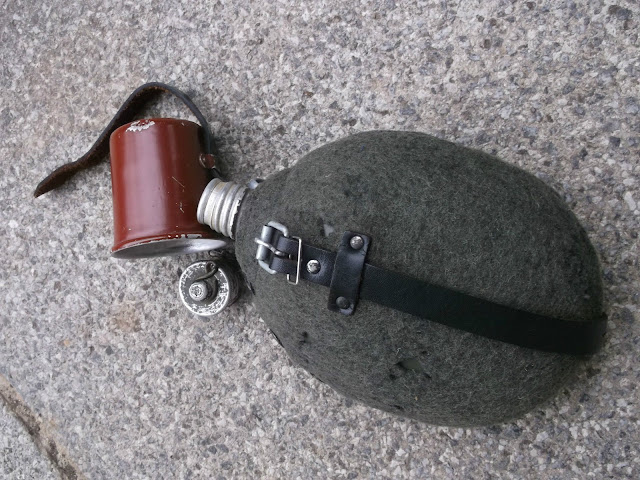 |
| Western Cutlery Shark Knife personalized by a sailor in TF58 after the raids on Tokyo, 2 - 16 - 45. |
Its not every day that a collector/historian has a documented piece of history fall into his lap, but the knife pictured above was offered for sale in an online auction by a seller that didn't know exactly what he had, besides, "Old Knife Stamped Tokyo." Well, that description is not likely to draw the attention of knife collectors that want World War Two era knives, or knives made by the Western Cutlery Company, Boulder, Colorado. I stumbled across it and bought it as soon as I realized what it was. My knife collecting karma was strong that day.
The Western Cutlery Company, like most sizeable knife companies during World War Two, produced a number of knives for military contracts as well as knives that were popular private-purchase knives carried by many GIs and Sailors around the globe. The model G-48-6 or Shark knife, as this model became known, had a 6 inch blade with a fuller and a false edge on top, a round, welded pommel (like the L71 "Seabee" knife which the USN accepted as the MK1) and leather washer handle with vulcanized, hard rubber spacers colored black, red, black, like many of their commercial knives. Western already had a history as one one of the few knife makers in America that was not centered around the New England area, the traditional area for American knife makers. Western opened shop in Boulder, Colorado, in 1896 and didn't close its doors until February, 2007. Western also produced the G-48-8, a knife that was very similar but had an 8 inch blade. The G-48-8 was accepted by the US Navy as a version of the MK2.
This particular knife not only has the stamping shown above, TOKYO - 2-16 - 45, but also has the sailor's name and rate stamped on the other side of the leather handle. The date was what caught my eye initially. February 16th, 1945, is only three days before the invasion of Iwo Jima. This knife was involved in an operation that had two historically significant characteristics. First was that the carrier based attack on Tokyo, 16 - 17 February, 1945, was the first such attack on Tokyo since the Doolittle Raid in April, 1942. Second, it was designed to draw Imperial Japanese Naval Air Forces away from Iwo Jima in order to allow the US Navy and Marine Corps to have air superiority over Iwo. This operation was carried out by Fast Carrier Task Force 58 and was labeled, "Operation Jamboree."
 |
| US Navy Pilots aboard the USS Essex (CV9) receive their briefings on February 16th, 1945, prior to attacking Tokyo. US Navy Photo, NARA. -U.S. Navy photo in NARA record group 80-G -U.S. Navy photo in NARA record group 80-G |
 |
| Two USS LEXINGTON (CV-16) SB2C-3 "Helldiver"
bombers fly over Task Force 58, enroute to Tokyo for their first raid on
that city, circa 16 February 1945. Ships below include an "Essex" class
carrier, a "New Orleans" class cruiser and a destroyer.US Navy photo, NARA. |
The air attack on Tokyo consisted of over one thousand aircraft. Naval aviation attacked Tokyo's industrial center, including aircraft manufacturing plants, Japanese military airfields, and ships in Tokyo harbor. The Japanese response was tepid and the attacks damaged aircraft and ships with little resistance.
The man that owned this knife is something of an enigma. His name, according to the stampings on the handle, was V. L. Moretti and his rate was SK 1/C, or Storekeeper 1st Class. He was an E-6 and worked in stores, or was a supply NCO, in Army parlance. How did a supply NCO get a knife? That one is not hard to imagine, he had access to all the stores. Did he actually fly on a mission over Tokyo? Perhaps, as stated there were over a thousand aircraft involved in the attack and dive bombers had a crew of two, a pilot and a machine gunner. Could our intrepid SK 1/C have flow as a gunner on a Helldiver? I think the chances are better than average. Now, there is such an sailor as an Aviation Storekeeper, but that rate was known as AS, not SK, like our hero.
 |
| Aviation Storekeeper 1st Class, AS 1/C |
 |
| Storekeeper 1st Class, SK 1/C | | |
|
|
|
|
|
 |
| The handle is marked, V.L.Moretti - SK 1/C |
I wish I knew more about this sailor and the story of his trip to Tokyo on 16 February, 1945, but I am content to know that this tiny piece of World War Two history has a safe and appreciative home in my collection. God Speed, SK 1/C Moretti. I hope to rally with you on the high ground.
On 19 February, 1945, three days,after SK 1/C Moretti's adventures over Tokyo, US Marines landed on Iwo Jima.
 |
| US Marines land on Iwo Jima, 19 February, 1945. |
Also, check out my YouTube video about this knife for video of the actual attack on Tokyo!!
https://www.youtube.com/watch?v=ahzJSVLXJnY
https://www.youtube.com/watch?v=ahzJSVLXJnY























































